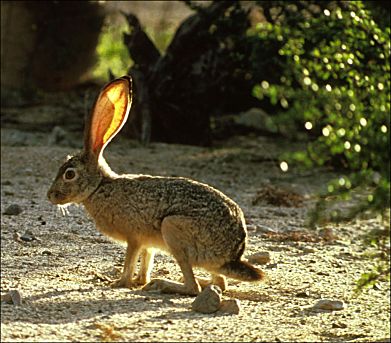

The ability of rabbits to make more rabbits is notorious—rapid reproduction is perhaps their main claim to fame. It took only a few short years after introduction for Old World rabbits to overrun Australia: only rabbit diseases saved the country. With rabbits of various kinds so common throughout the Chihuahuan Desert, what keeps us from being another Australia with a rabbit behind every bush. The answer, of course, is a set of effective predators.
Eurasian and American rabbits have a long evolutionary history of
confrontation with predators, with strong competition by each to survive—the rabbits by
escaping and the predator by bringing down prey. This history finely honed the skills
of each through age-long escalations. Those rabbits who became most competent at
avoidance survived to produce a generation of faster rabbits; only the best predators
lived to reproduce a more efficient generation. But in the small continent of
Australia, there were no predators equal to the task of restraining rabbit populations.
So thank our coyotes, foxes, bobcats, and raptorial birds for keeping our desert
rabbits merely abundant.

Contributor: Arthur H. Harris, Laboratory for Environmental Biology, Centennial Museum, University of Texas at El Paso.
Desert Diary is a joint production of the Centennial Museum and KTEP National Public Radio at the University of Texas at El Paso.

One of the Chihuahuan Desert's native rabbits, the Black-tailed Jack Rabbit (Lepus californicus). Photograph courtesy of the U.S. Fish and Wildlife Service.